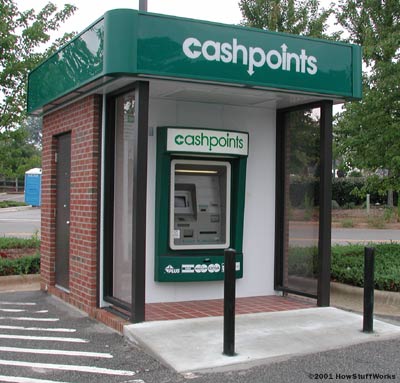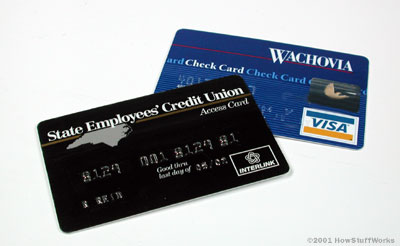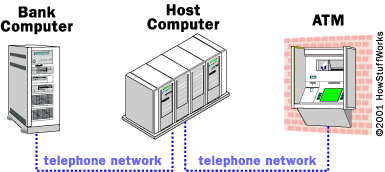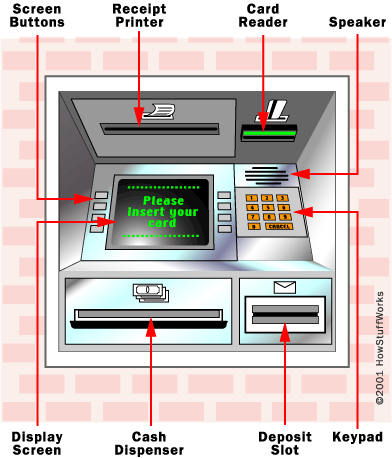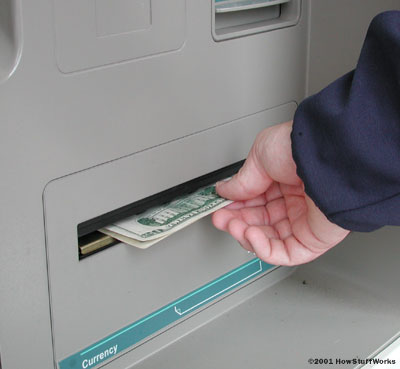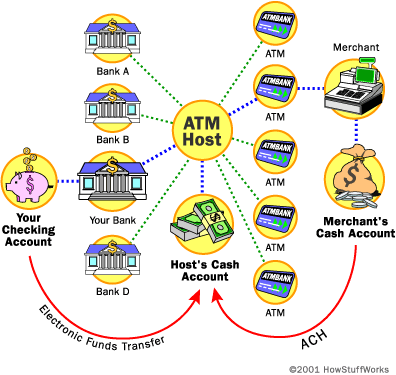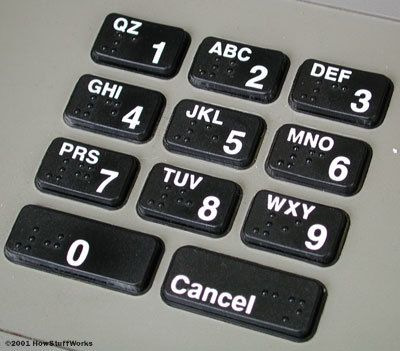| Haw Automated Teller Machines (ATMs)
Work | ||||||||||
You're short on cash, so you walk over to the automated teller machine (ATM), insert your card into the card reader, respond to the prompts on the screen, and within a minute you walk away with your money and a receipt. These machines can now be found at most supermarkets, convenience stores and travel centers all over the country from coast to coast. But have you ever wondered about the process that makes your bank funds available to you at any of the thousands of ATMs?
In this edition of HowStuffWorks, we will look at the ATM device that allows you access to your money and examine the network that the ATM connects to.
ATM Card vs. Check Card Check cards are different from straight ATM cards in a couple of ways. First, check cards are also known as debit cards because of how they work -- instead of getting credit for your purchase and receiving a monthly bill, like you do with a credit card, a check/debit card deducts money from your checking or savings account. Also, while you can only use your ATM card at the ATM machine (and some grocery stores), you can use a check card at any retailer that accepts credit cards, such as:
You can use your check card as a either credit card or a debit card -- either way, it comes out of your account. The only difference is that if you tell the clerk "credit card," you sign a slip, and if tell the clerk "debit card," you enter your PIN number instead of signing. It's easy to tell the difference between a plain ATM card and a check card: A check card has your name, "credit" account number, the credit company's logo, the bank's logo and "Check Card" printed across the front of it; an ATM card has only your name, account number and bank's logo on the front of it. Both cards have strips on the back for the authorized cardholder to sign on. A check card company, such as Visa, has agreements with banks to issue what looks like a Visa credit card. A Visa check card can be used at any retailer that accepts Visa credit cards and at ATMs worldwide.
How Do ATMs Work?
Most host processors can support either leased-line or dial-up machines. Leased-line machines connect directly to the host processor through a four-wire, point-to-point, dedicated telephone line. Dial-up ATMs connect to the host processor through a normal phone line using a modem and a toll-free number, or through an Internet service provider using a local access number via a modem. Leased-line ATMs are preferred for very high-volume locations because of their thru-put capability, and dial-up ATMs are preferred for retail merchant locations where cost is a greater factor than thru-put. The initial cost for a dial-up machine is less than half that for a leased-line machine. The monthly operating costs for dial-up are only a fraction of the costs for leased line. The host processor may be owned by a bank or financial institution, or it may be owned by an independent service provider. Bank-owned processors normally support only bank-owned machines, whereas the independent processors support merchant-owned machines.
Parts of the Machine
And an ATM has four output devices.
The cash-dispensing mechanism has an electric eye that counts each bill as it exits the dispenser. The bill count and all of the information pertaining to a particular transaction is recorded in a journal. The journal information is printed out periodically and a hard copy is maintained by the machine owner for two years. Whenever a cardholder has a dispute about a transaction, he or she can ask for a journal printout showing the transaction, and then contact the host processor. If no one is available to provide the journal printout, the cardholder needs to notify the bank or institution that issued the card and fill out a form that will be faxed to the host processor. It is the host processor's responsibility to resolve the dispute. Besides the electric eye that counts each bill, the cash-dispensing mechanism also has a sensor that evaluates the thickness of each bill. If two bills are stuck together, then instead of being dispensed to the cardholder they are diverted to a reject bin. The same thing happens with a bill that is excessively worn or torn, or is folded.
The number of reject bills is also recorded so that the machine owner can be aware of the quality of bills that are being loaded into the machine. A high reject rate would indicate a problem with the bills or with the dispenser mechanism.
Settlement Funds
ATM Security
Visa also recommends the following tips for safe ATM usage:
Many retail merchants close their store at night. It is strongly recommended that they pull the money out of the machine when they close, just like they do with their cash registers, and leave the door to the security compartment wide open like they do with an empty cash-register drawer. This makes it obvious to any would-be thief that this not payday.
For safety reasons, ATM users should seek out a machine that is located in a well-lighted public place. Federal law requires that only the last four digits of the cardholder's account number be printed on the transaction receipt so that when a receipt is left at the machine location, the account number is secure. However, the entry of your four-digit personal identification number (PIN) on the keypad should still be obscured from observation, which can be done by positioning your hand and body in such a way that the PIN entry cannot be recorded by store cameras or store employees. The cardholder's PIN is not recorded in the journal, but the account number is. If you protect your PIN, you protect your account.
New
Innovations
New innovations in this technology will include machines that will verbally prompt the customer for their card, their PIN and what type of transaction they would like. For more information on ATMs and related topics, check out the links on the next page.
Links Related HowStuffWorks Links
Other Great Links
|
